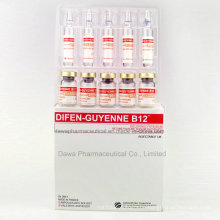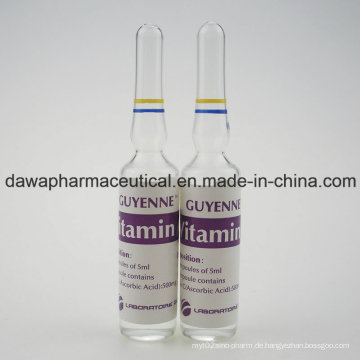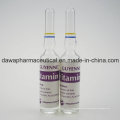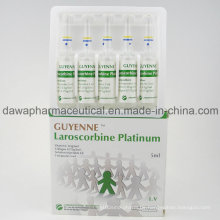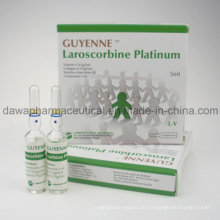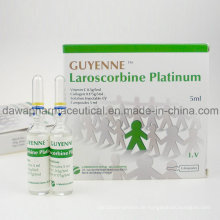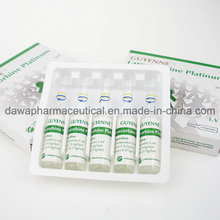Ready Stock Folsäure Vitamin B9 & Vitamin Bc & Vitamin M
Basisinformation
Modell: HEA451856M
Produktbeschreibung
Modell Nr .: HEA451856M Verwendungsart: Für die orale Verabreichung Form: Oral Liquid Pharmazeutische Technologie: Chemische Synthese Marke & Herkunft: Guyenne, Frankreich Verpackung: 10 AMPS/Tray/Box Probe: Akzeptable Qualität Standard: GMP / Euro GMP Warenzeichen: Guyenne Herkunft: Frankreich Anwendung: Internal Medicine Zustand: Flüssig Typ: Biologische Produkte Name: Folsäure Spezifikationen: 10mg / Ml MOQ: 1 Box Lieferzeit: 7 Tage Haltbarkeit: 36 Monate Spezifikation: GMP / WHO GMP / EURO GMP HS Code: 3004909090 Namen
Identifikatoren
EigenschaftenPharmakologie
Folsäure oder Folsäure ist ein B-Vitamin & Periode; Es wird auch als Vitamin M, Vitamin B9, Vitamin Bc, & lp; oder Folacin & rar ;, Pteroyl-L-glutaminsäure und Pteroyl-L-glutamat & Periode;
Nahrungsergänzungshersteller verwenden oft den Begriff Folat für etwas anderes als "reine" Folsäure: In der Chemie bezieht sich Folat auf das deprotonierte Ion und Folsäure auf das neutrale Molekül, die beide in Wasser und Periode koexistieren; Die Internationale Vereinigung für reine und angewandte Chemie und die Internationale Vereinigung für Biochemie und Molekularbiologie behaupten, dass Folat und Folsäure die bevorzugten Synonyme für Pteroylglutamat bzw. Pteroylglutaminsäure bzw. Periode sind;
Vitamin B9 ist wichtig für zahlreiche Körperfunktionen & Periode; Menschen können nicht Folaten de novo & semi; Daher muss Folsäure durch die Diät geliefert werden, um ihre täglichen Anforderungen und Periode zu erfüllen; Der menschliche Körper braucht Folsäure, um DNA zu synthetisieren, DNA zu reparieren und DNA zu methylieren sowie als Cofaktor in bestimmten biologischen Reaktionen und Perioden zu wirken; Es ist besonders wichtig bei der Förderung der schnellen Zellteilung und des Wachstums, wie in der Kindheit und Schwangerschaft & Periode; Kinder und Erwachsene erfordern Folat, um gesunde rote Blutkörperchen zu produzieren und Anämie und Periode zu verhindern;
Ein Mangel an diätetischen Folaten kann zu Folatmangel und Periode führen. Ein vollständiger Mangel an diätetischem Folat dauert Monate bevor Mangel sich entwickelt, wie normale Individuen etwa 500-20.000 Mikrogramm & lpar; Μg & rarr; Von folat in körper speichert & zeit; Dieser Mangel kann zu vielen gesundheitlichen Problemen führen, wobei der bemerkenswerteste Neuralrohrdefekt bei der Entwicklung von Embryonen ist - ein relativ seltener Geburtsdefekt, der 300.000 & lt; 0 & Periode, 2 & amp; Geburten weltweit jedes Jahr und 3.000 Schwangerschaften in den Vereinigten Staaten jedes Jahr & Zeitraum; Häufige Symptome des Folatmangels sind Diarrhoe, makrozytäre Anämie mit Schwäche oder Kurzatmigkeit, Nervenschäden mit Schwäche und Gliedmaßen Taubheit & lip; periphere Neuropathie und Schwangerschaftskomplikationen, geistige Verwirrung, Vergesslichkeit oder andere kognitive Defizite, psychische Depressionen, wunde oder geschwollene Zunge, Peptische oder Mundgeschwüre, Kopfschmerzen, Herzklopfen, Reizbarkeit und Verhaltensstörungen & Periode; Niedrige Gehalte an Folsäure können auch zu Homocystein-Akkumulation und Periode führen; Niedrige Mengen an Folsäure wurden mit bestimmten Krebsarten und Perioden assoziiert; Es ist jedoch nicht klar, ob das Verzehr der empfohlenen & lpar; Mengen an Folsäure - aus Lebensmitteln oder in Ergänzungen - können das Krebsrisiko in manchen Menschen und Perioden senken;
Identifikatoren
EigenschaftenPharmakologie
| Folic acid | |
| IUPAC name (2S)-2-[[4-[(2-Amino-4-oxo-1H-pteridine6-yl)methylamino]benzoyl]amino]pentanedioic acid | |
|
Other names N-(4-{[(2-amino-4-oxo-1,4-dihydropteridin-6-yl)methyl]amino}benzoyl)-L-glutamic acid; pteroyl-L-glutamic acid; Vitamin B9; Vitamin Bc; Vitamin M; Folacin | |
|
CAS Number |
59-30-3 |
| ChEBI | CHEBI:27470 |
| ChEMBL | ChEMBL1622 |
| ChemSpider | 5815 |
| DrugBank | DB00158 |
|
IUPHAR/BPS |
4563 |
| Jmol interactive 3D | Image |
| KEGG | C00504 |
| PubChem | 6037 |
| RTECS number | LP5425000 |
| UNII | 935E97BOY8 |
|
Chemical formula |
C19H19N7O6 |
| Molar mass | 441.40 g·mol?1 |
| Appearance | yellow-orange crystalline powder |
| Melting point | 250 °C (482 °F; 523 K) (decomposition) |
|
Solubility in water |
1.6 mg/L (25 °C) |
| log P | -2.5 |
| Acidity (pKa) | 1st: 4.65, 2nd: 6.75, 3rd: 9.00 |
| ATC code | B03BB01 |
Folsäure oder Folsäure ist ein B-Vitamin & Periode; Es wird auch als Vitamin M, Vitamin B9, Vitamin Bc, & lp; oder Folacin & rar ;, Pteroyl-L-glutaminsäure und Pteroyl-L-glutamat & Periode;
Nahrungsergänzungshersteller verwenden oft den Begriff Folat für etwas anderes als "reine" Folsäure: In der Chemie bezieht sich Folat auf das deprotonierte Ion und Folsäure auf das neutrale Molekül, die beide in Wasser und Periode koexistieren; Die Internationale Vereinigung für reine und angewandte Chemie und die Internationale Vereinigung für Biochemie und Molekularbiologie behaupten, dass Folat und Folsäure die bevorzugten Synonyme für Pteroylglutamat bzw. Pteroylglutaminsäure bzw. Periode sind;
Vitamin B9 ist wichtig für zahlreiche Körperfunktionen & Periode; Menschen können nicht Folaten de novo & semi; Daher muss Folsäure durch die Diät geliefert werden, um ihre täglichen Anforderungen und Periode zu erfüllen; Der menschliche Körper braucht Folsäure, um DNA zu synthetisieren, DNA zu reparieren und DNA zu methylieren sowie als Cofaktor in bestimmten biologischen Reaktionen und Perioden zu wirken; Es ist besonders wichtig bei der Förderung der schnellen Zellteilung und des Wachstums, wie in der Kindheit und Schwangerschaft & Periode; Kinder und Erwachsene erfordern Folat, um gesunde rote Blutkörperchen zu produzieren und Anämie und Periode zu verhindern;
Ein Mangel an diätetischen Folaten kann zu Folatmangel und Periode führen. Ein vollständiger Mangel an diätetischem Folat dauert Monate bevor Mangel sich entwickelt, wie normale Individuen etwa 500-20.000 Mikrogramm & lpar; Μg & rarr; Von folat in körper speichert & zeit; Dieser Mangel kann zu vielen gesundheitlichen Problemen führen, wobei der bemerkenswerteste Neuralrohrdefekt bei der Entwicklung von Embryonen ist - ein relativ seltener Geburtsdefekt, der 300.000 & lt; 0 & Periode, 2 & amp; Geburten weltweit jedes Jahr und 3.000 Schwangerschaften in den Vereinigten Staaten jedes Jahr & Zeitraum; Häufige Symptome des Folatmangels sind Diarrhoe, makrozytäre Anämie mit Schwäche oder Kurzatmigkeit, Nervenschäden mit Schwäche und Gliedmaßen Taubheit & lip; periphere Neuropathie und Schwangerschaftskomplikationen, geistige Verwirrung, Vergesslichkeit oder andere kognitive Defizite, psychische Depressionen, wunde oder geschwollene Zunge, Peptische oder Mundgeschwüre, Kopfschmerzen, Herzklopfen, Reizbarkeit und Verhaltensstörungen & Periode; Niedrige Gehalte an Folsäure können auch zu Homocystein-Akkumulation und Periode führen; Niedrige Mengen an Folsäure wurden mit bestimmten Krebsarten und Perioden assoziiert; Es ist jedoch nicht klar, ob das Verzehr der empfohlenen & lpar; Mengen an Folsäure - aus Lebensmitteln oder in Ergänzungen - können das Krebsrisiko in manchen Menschen und Perioden senken;
1 Health effects
National Institutes of Health & lpar; US & rpar; Ernährungsbedürfnisse & lt; μg pro Tag & rp. AlterInfants & lrrrrrrrrrrrrrrrrrrrrrrrrrrrrrrrrrrrrrrrrrrrrrrrrrrrrrrrrrrrrrrrrrrrrrrrrrrrrrrrrrrrrrrrrrrrrrrrrrrrrrrrrrrrrrrrrrrrrrrrrrrrrrrrrrrrrrrrrrar UL & rpar;
Produktgruppe : Anti-Age-Produkte andere Produkte
heiße Produkte Hochwertige 200mg Amiodaron-Hydrochlorid-TablettenLarge Stock Whiten Haut Monobenzone CremeAllgemeine Medizin Omeprazol 20mg Injektion für Gastrohelkose und MagensäureAllgemeine Medizin Ceftriaxone Natrium InjektionReady Stock Skin Whitening Anti-Aging Vitamin C InjektionOEM Tablette 500mg ParacetamolHochwertige 500mg Hartkapseln Amoxicillin (Amoxycillin)Bester und niedriger Preis Ceftriaxon Natrium Injektion CeftriaxonBeste Qualität Omega 3 Deep Sea Softgel Kapsel Fisch ÖlFDA zugelassenes kuratives AntimalariaparisininMedizin Behandlung Hirnverletzung Citicolin Natrium InjektionProtease Alpha Chymolase für entzündliche ÖdemeAllgemeine Medizin Medroxyprogesteron Acetat InjectionAmikacin Injektion Allgemeinmedizin DrogenHautaufhellung Gsh Körperpflege Glutathion InjektionKörper abnehmen Fitness verlieren Gewicht Gewichtsverlust L-Carnitin Injection2.0g / 5ml |


